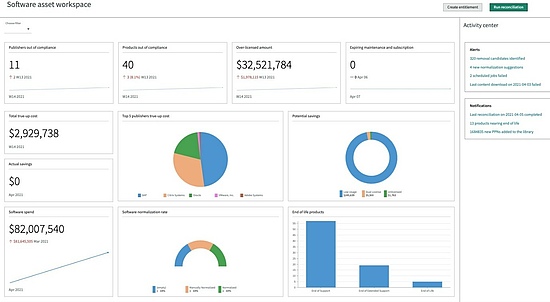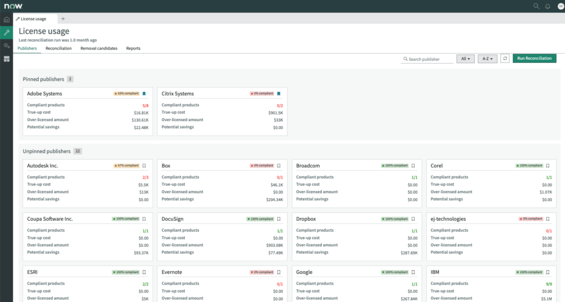ServiceNow Rome Release: highlights
ServiceNow Rome has been released in September 2021. In this post, we will share some highlights.
New release - September 2021: Find out what's new in the Rome release when it comes to Software Asset Management & Hardware Asset Management.
Highlights of this page
Software Asset Management
Reconciliation for subscription and consumption based SaaS applications
As part of the new ServiceNow reconciliation framework, you can now view the reconciliation results for your SaaS applications in the license workbench. You can now determine your license compliance by automatically reconciling subscription and consumption based SaaS applications.
BYOL (Bring your own license) for Oracle Database servers
ServiceNow has extended their BYOL license support for Oracle Database servers on AWS and Microsoft Azure. You can determine your license compliance position for these Oracle Database versions that are deployed across various hybrid infrastructures, including IaaS and PaaS:
- Oracle Database Standard Edition
- Oracle Database Standard Edition One
- Oracle Database Standard Edition 2
- Oracle Database Enterprise Edition
SAP S/4HANA publisher pack
Manage your SAP S/4HANA named user and industry solution (engine) licenses with this new publisher pack. This pack includes support for creating entitlements, software models, license usage tracking and determining license compliance for SAP S/4HANA.
Office 365 license optimisation
ServiceNow has added recommendations and support for downgrading Office 365 licenses to lower-cost licenses and also for removing legacy Microsoft office deployments, based on the Office 365 usage data.
The new user-friendly Software Asset Workspace
ServiceNow has introduced an optional, completely new look and feel with the new user-friendly Software Asset Workspace. This new more intuitive UI comes with some great new features that we will elaborate on in next week’s post.
With the Rome release, ServiceNow introduces a completely new look & feel for their graphical user interface. This new user-friendly Software Asset Workspace feels more intuitive and enables efficient working.
The Software asset overview landing page
The new workspace starts with the Software asset overview landing page. This page is the starting point where key metrics, such as compliance trends, true-up costs, potential savings and normalisation rates can be viewed. In addition, you can execute routine tasks such as running a reconciliation or creating entitlements from here, without the need to navigate to those application menus first. Lastly, the page features alerts and notifications with actionable insights. In short, this page features all the key SAM aspects for daily use in one environment.
License Usage View
The license workbench, where compliance information could be viewed in earlier ServiceNow releases, also got a re-do in the Software Asset Workspace. It is now called the License Usage View, and it shows you more detailed license compliance information in a more user-friendly way. You can pin your key publishers so they are at the top of the page. For each publisher a compliance percentage is shown, so you can assess how close to compliance you are for that specific publisher. So, compliance isn’t just a yes or no anymore. To top things off, the view also features when the last reconciliation was run or you can run a reconciliation and view its results. All on the same page.
Guided walk-through Playbooks
A new feature that was added is the Playbook for Software Asset Management. A Playbook is a step-by-step walk-through that guides you through daily SAM activities. Each playbook consists of a list of tasks that you need to perform, status indicators that display the current state of each task and check boxes that indicate where you are in the workflow. You can create your own playbooks that others can use to get guided through a task, or use the already available entitlement creation playbook.
When a product is faulty, the buyer can return the product for replacement or repair, using a Return Merchandise Authorization (RMA) process. This process will now be supported in ServiceNow HAM 3.0 using prescriptive workflows. Based on the agreements with vendors, these workflows can be tailored to specific products and vendors with various actions like getting the assets repaired off-site or on-site, or direct replacement of the assets. You can streamline all the actions that need to be performed when an asset becomes faulty.
New Asset Health tab in the Hardware Asset Dashboard
The Hardware Asset dashboard also got an upgrade in the Rome release, adding the Asset Health tab. This tab shows assets with missing purchase information, assets that are undiscovered over a period of a month or more, assets that are nearing their scheduled retirement date or assets that are reported with a high number of incidents. All this information can also be filtered by location or by hardware model, to get more location or model specific results.
Save money by only licensing the resource categories you use
ServiceNow introduces the option to save money on your HAM application license by opting in or out of the resource categories, based on what you use. These categories are End User Computers (subscription ratio 4:1), Servers (5:1), Network Gear (1:1) and Mobile Devices (10:1). So, save money and opt out of the functionalities you don’t use!
CSDM framework implementation
The Common Service Data Model (CSDM) will be implemented in phases in HAM with the Rome release. The CSDM is a standard and consistent set of terms & definitions through the whole ServiceNow platform. CSDM in HAM will provide the ability to use a standard set of fields and values to help effectively track assets through their lifecycle transitions.

